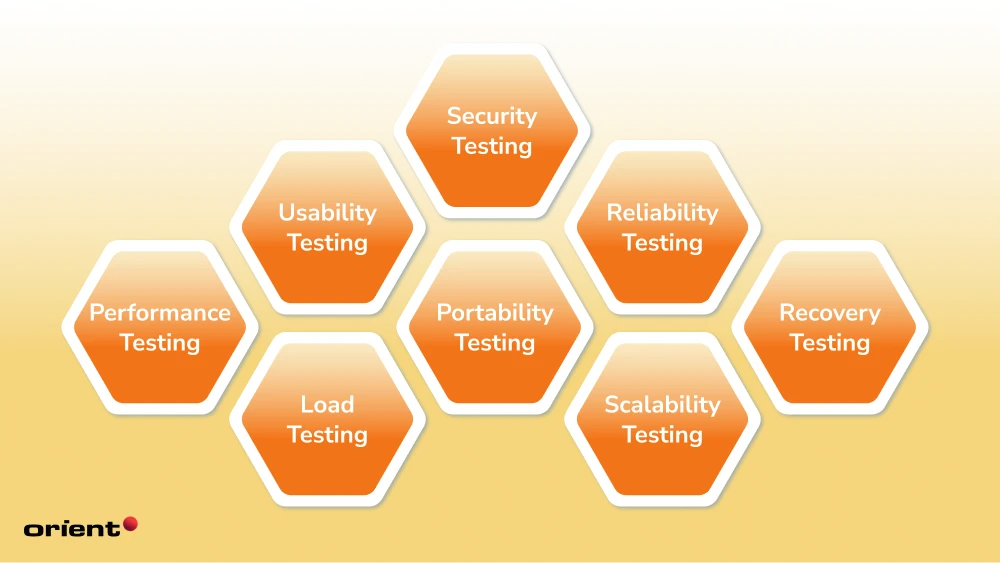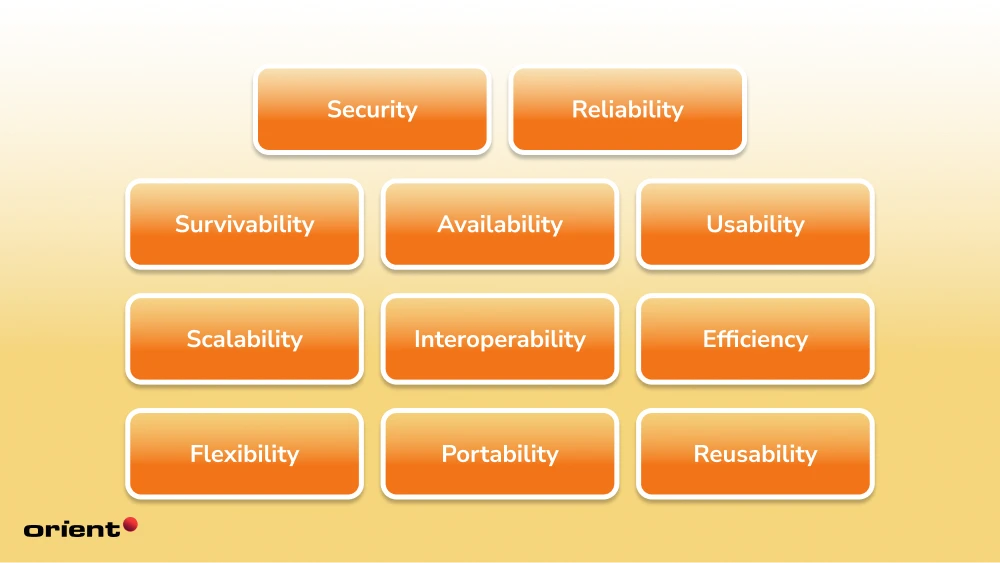
Non-Functional Testing: A Complete Handbook for Developers

Content Map
More chaptersNon-functional testing is the unsung hero of the quality assurance field. Proper non-functional testing ensures that the application is not only feature-rich but also reliable and scalable. It prevents sudden crashes and performance hiccups, ensuring the best possible user experience.
In this article, we’ll explore the key aspects of non-functional testing—what it is, its objectives, test types, and crucial metrics.
Key Takeaways:
- Non-functional testing evaluates an app’s non-functional aspects, such as its performance, usability, and performance.
- Non-functional testing aims to deepen the understanding of the product to effectively improve it.
- The improvement of non-functional aspects of the product are done via clear metrics and various test types, including performance testing, usability testing, security testing, scalability testing, etc.
- Even though non-functional testing is key to a seamless and consistent user experience, it can be resource-intensive and costly.
What Is Non-Functional Testing and Its Objective?

Definition
Non-functional testing is a type of software testing that evaluates an application’s non functional aspects, such as performance, security, usability, and reliability. Unlike functional testing, which verifies what the system does, non-functional testing focuses on how well the system performs under various conditions, ensuring its stability, scalability, and overall readiness for deployment.
Objective
Non-functional testing entails five core objectives:
- Improve the product’s usability, maintainability, portability, and efficiency.
- Optimize product operations: streamline installation, setup, execution, management, and monitoring processes of the product.
- Reduce production risks and costs related to the non-functional aspects of the product.
- Gather metrics for improvement: Research, collect, and report metrics for research and development so teams can continue to improve the product.
- Enhance understanding of product behavior: One way to improve the software application’s performance is by deepening knowledge of its behavior and technology.
Characteristics of Non-Functional Testing

The distinctive characteristics of non-functional testing can be summarized into four main points:
- Non-functional tests are objective and measurable, so there is clear expectation regarding the system’s performance. The tests shouldn’t be characterized with vague adjectives like good, bad, best, etc.,
- During the early stages of gathering requirements, it is unlikely that the numbers are fully defined. The metrics might become clearer through more thorough discussion and testing.
- Non-functional requirements must be prioritized so the most critical aspects of system operation are addressed first.
- Testers need to ensure that all quality attributes (usability, security, etc.) are thoroughly identified in software engineering. Ensuring accuracy early on prevents any potential problems post-deployment in the software system.
Non-Functional Test Types

To ensure comprehensive testing, non-functional testing is categorized into multiple key types, each targeting a different aspect of the system’s performance and quality attributes.
Performance Testing
Performance testing determines the application’s stability, speed, scalability, and responsiveness under a certain workload. It is used to ensure software quality. To be specific, performance testing examines the app’s processing speed, network bandwidth usage, application output, maximum concurrent users, workload efficiency, and response times.
- Example test case: Validate that the website’s response time remains within 4 seconds when accessed simultaneously by 1,000 users.
Usability Testing
Usability testing refers to the evaluation of users’ experience when interacting with the application. By having real users (not developers or designers) complete a number of tasks on the application, the team can analyze and identify issues for improvement. Direct user input is invaluable in achieving the best positive experience upon release.
- Example test case: Test the checkout process on an e-commerce website to identify any confusing steps. This is a real problem for many e-commerce sites as statistics have shown more than half of customers abandon their shopping carts if the checkout procedure takes more than 30 seconds.
Load Testing
Load testing is considered a type of performance testing. It checks how the system behaves under a certain workload over a period. The test measures how the system handles expected load volumes before behaving negatively.
- Example test case: Users trying to download multiple files at the same time.
Security Testing
Security testing identifies the operating systems’ vulnerabilities. It ensures that the software is safe from data breaches, malicious attacks, and unauthorized attacks. Additionally, this test type also checks the software’s compliance with regulations and standards. Security testing can be broken down into several categories, including risk assessments, vulnerability testing, penetration testing, and so on.
- Example test case: A hacker is trying to use numerous combinations to guess a user’s login credentials.
Portability Testing
Portability testing checks to see how easy it is to transfer a software application from one environment to another. This test is conducted regularly to identify any dependencies on hardware or specific platforms and ensure end-users have the most seamless experience regardless of the platform they use.
- Example test case: Testing a mobile app on different operating systems.
Reliability Testing
Reliability testing evaluates a system’s ability to perform consistently and reliably in a variety of conditions. This test type aims to provide a consistent user experience by uncovering the root causes of failures and simulating different user patterns, conditions, and data loads.
- Example test case: Test the app’s ability to handle large data loads over 24 hours, simulating different user patterns and network conditions.
Scalability Testing
Scalability testing involves testing and validating a system, network, or component performance by increasing or decreasing load. This test aims to examine the system’s behavior under extreme conditions and measures when the app stops scaling to identify possible reasons.
- Example test case: Test the app’s behavior when large numbers of users access the app at the same time.
Recovery Testing
Recovery testing evaluates a system’s ability to recover from a failure. The system is forced to crash so the team can note the recovery rate in cases of hardware crashes, power outages, signal loss, etc.
- Example test case: Test the system’s reboot time when there is a power outage.
Non-Functional Testing Metrics

There are non functional testing parameters present to validate an application during the software testing process. Not every testing case requires the presence of all these testing metrics. However, recovery, reliability, security, and usability are key parameters that should be kept in mind at all times.
Security
This metric measures how the software is protected against threats and sudden attacks. It ensures the data is protected and no unauthorized access is made.
Reliability
This metric evaluates the system’s ability to perform as intended consistently over a period of time without failing.
Survivability
In the event of failure or external attack, survivability measures how well the system recovers and continues to function.
Availability
This metric determines the percentage of time the system is operational and accessible to users.
Usability
This parameter considers user experience and ease of navigation. It focuses and assesses how easy it is for users to interact with the system.
Scalability
Scalability tests how well the system can handle growth (scaling up) or shrinkage (scaling down) without negatively impacting the performance.
Interoperability
This parameter validates the app’s ability to work with other environments, systems, or software.
Efficiency
With this metric, testers measure how well the system optimizes resources like memory, CPU, and bandwidth for the best performance.
Flexibility
More than scaling up or down, flexibility evaluates how well the system adapts to changes and updates.
Portability
Portability determines how easily the system can be transferred or adapted to different environments or platforms.
Reusability
Reusability checks to see if the app’s codes or components can be modified for usage in other applications.
Pros and Cons of Non-Functional Testing

Every test type is performed due to benefits. However, they often come with limitations as well. Here is a closer look at the pros and cons of non-functional testing.
Pros
- Better performance: Non-functional testing ensures that problems affecting the application’s performance are addressed and handled.
- Less time-consuming: Among numerous testing procedures, non-functional tests are generally not as time-consuming.
- Consistent user experience: Keeping the users at the heart of the tests, non functional tests ensure that the apps are user-friendly.
- Secure software: More than performance, the tests ensure that the app is safe against threats and malicious attacks.
Cons
- Resource intensive: non-functional testing needs to be conducted after changes are implemented in the application. Their repetitive nature might require more resources.
- Costly: Again, the resource-intensiveness of each update of non functional testing might incur more costs to re-evaluate the software.
Last Note
Non-functional testing plays a crucial role in ensuring high-quality software. While its improvements might not be as dramatic as functional testing, it’s a vital part of the software development lifecycle that can make the big difference between a successful product and a failed one.
Managing multiple tests at once can be overwhelming, but you can’t afford to skimp the testing phase in today’s competitive digital landscape. This is where experts like Orient Software come in - to provide you with the best test visibility and easy management of both functional and non-functional testing. Contact us today to elevate your application to new heights!
FAQs
What is the difference between functional and non-functional testing?
Functional testing verifies that the software performs its intended tasks, while non-functional testing assesses how well the software performs under various conditions, focusing on attributes like performance and reliability. Functional tests ensure the code meets business requirements, while non-functional tests refine aspects such as scalability and user experience. Together, they form a comprehensive testing strategy.
Is API testing functional or nonfunctional?
API testing is functional testing. It checks to see if the API performs its functions as intended correctly: whether the API endpoint returns the correct responses, handles requests correctly, and meets business requirements.
API testing might also involve non-functional aspects like performance (response times) and security, but its core is still functional testing.






